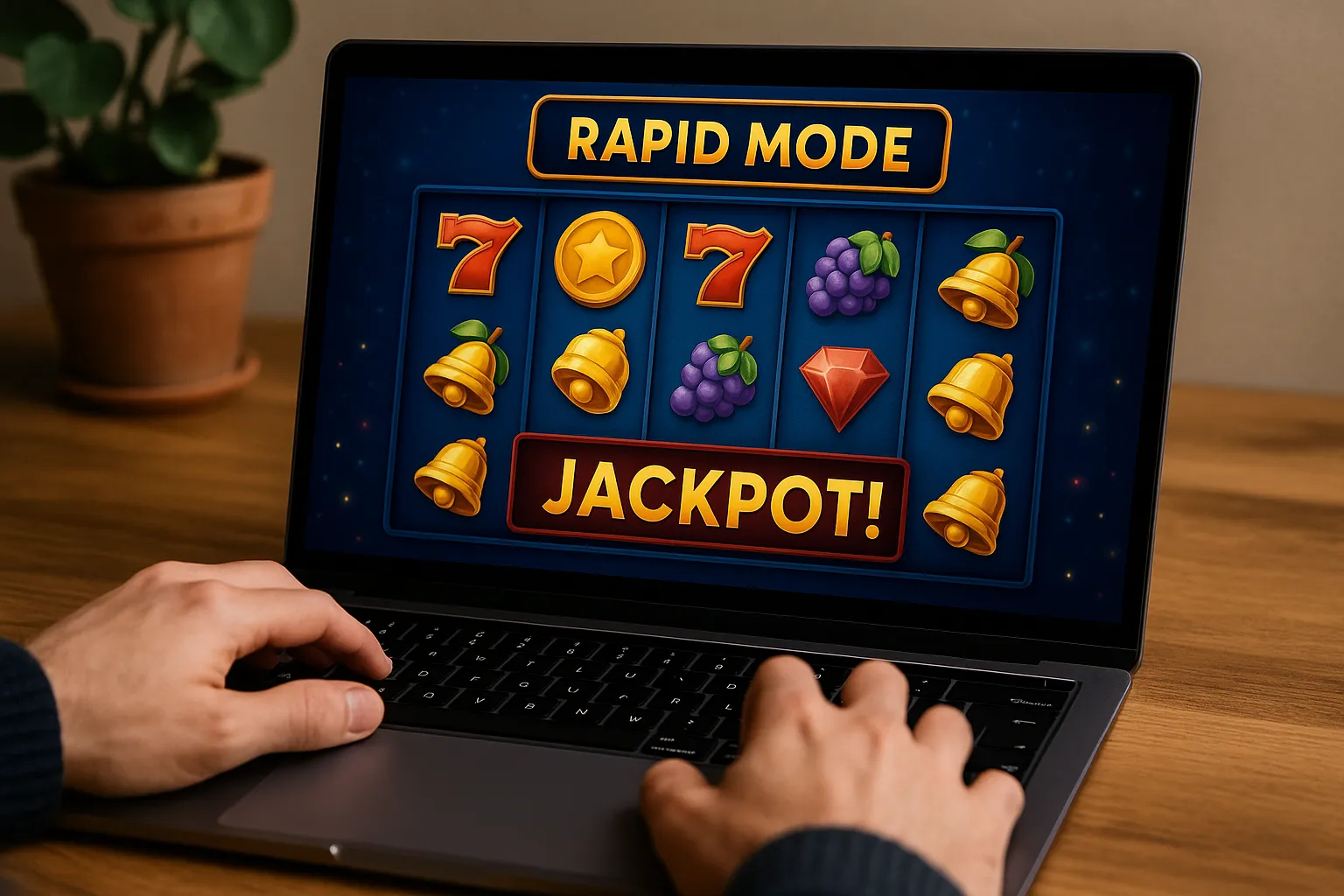I still remember the first time I flicked a slot into “rapid” (sometimes labeled turbo, quick spin, lightning, ultra, or fast play). The reels snapped to a halt almost instantly and within minutes I’d completed what would normally have taken half an hour. It felt like I was powering toward a jackpot. But feelings and math are two very different beasts. So can rapid mode really unlock jackpots faster, or is it just an illusion of progress designed to compress time and keep experienced players engaged? Let’s unpack what’s going on under the hood, how probability behaves, and how to use (or ignore) rapid mode intelligently.
The core truth: rapid mode does not change the underlying Random Number Generator (RNG) odds. Each spin—regular, turbo, or quick—requests an outcome from the same RNG pool. What changes is only time between decisions. Rapid mode lets you experience more independent trials per minute. That higher spin velocity can arrive at a rare event (like a jackpot) in fewer minutes, but never in fewer spins. This distinction is where many misconceptions grow. I’ve watched friends swear rapid mode is “hot” simply because they witnessed a big hit soon after toggling it on. Really, they just fit more trials into a shorter clock window.
When evaluating platform options—whether land-based terminals, mainstream regulated apps, or specialized communities on non GamStop casinos—it’s important to ground expectations in math, not marketing labels. Rapid features exist primarily to streamline animation, shorten reel travel time, skip non-essential celebration sequences, and accelerate auto-play scripts. They’re also a user-experience response: seasoned players don’t always want theatrical delays every spin; they want data (balance change, hit rate, bonus frequency) quickly.
What Rapid Mode Technically Does
In a standard online slot, each spin sequence includes: input (click), RNG call, reel animation timeframe (often 2.5–4 seconds), result evaluation, win animation, optional feature triggers, and then readiness for the next spin. Rapid or turbo mode typically shortens or removes: extended reel rolling, bounce/anticipation frames, symbol highlight cycles, and full-length win celebrations. Some games also silence (or condense) audio stingers. The net effect: cycle time might drop from ~3 seconds to ~0.8 seconds or even less.
Because of that compression, you might push 70–80 spins in five minutes versus 30–40 at default speed. If a jackpot has a 1 in 50,000 probability per spin (illustrative example), your expected jackpot frequency remains 1/50,000. However, by doubling your spins per minute you halve the clock time to reach the expected trial count. That’s time efficiency, not probability advantage.
Rapid Mode and Bankroll Volatility
Spinning faster magnifies volatility exposure per minute. Losses and wins arrive in quicker succession, shrinking the psychological recovery period after downturns. Your bankroll’s standard deviation per spin is constant; per minute it grows with spin density. I’ve seen disciplined players activate turbo only in bonus hunts (targeting scatter triggers across multiple games) then revert to normal speed to moderate emotional pacing once a feature begins.
A practical mental model: treat each session goal (e.g., 400 spins) as a spin budget not a time budget. If you normally stretch 400 spins over an hour but turbo them into 25 minutes, your statistical outcome distribution is identical, but your subjective sense of “losing fast” or “hitting fast” intensifies. This amplification can push impulsive bankroll top-ups if you don’t predefine limits.
Impact on RTP and Jackpot Mechanics
Return to Player (RTP) percentages are long-run theoretical expectations derived from the symbol weighting, paytable, and feature frequencies coded into the math model. Rapid mode doesn’t alter symbol tables, progressive meter increments, seed values, or bonus weighting. Progressive jackpots that increment with wager contribution continue to accrue at the same proportional rates; you just contribute more frequently in less time if you maintain the same stake size per spin.
Some mystery jackpots or time-based “must-drop before” pots appear to sync well with rapid mode. But you’re simply consuming more entries. If a must-drop pool must hit before reaching £10,000 and historically drops around £9,732, rapid mode can help you participate in more of the final approach spins within a real-time window—but so can manual fast clicking. There’s no secret acceleration of the threshold mechanism itself.
Player Psychology: The Illusion of Momentum
Rapid mode capitalizes on cognitive biases:
Recency bias & pattern seeking: Faster spins create denser sequences of outcomes. Your brain stitches near-misses and small wins into perceived streaks.
Gambler’s fallacy: Compression erodes cooldown intervals where rational recalibration could occur (“I’ve had 200 dead spins; a bonus is due” feels stronger when those 200 land in 12 minutes).
Time distortion: Fewer contextual cues (animations, audio flourishes) reduce memory encoding; long turbo sessions can feel like a short burst, masking actual wagering volume.
Recognizing these biases lets you frame rapid mode as a tool rather than an emotional accelerator.
Bankroll Management Strategies in Rapid Mode
Before enabling turbo, I outline three guardrails:
Spin Count Cap: e.g., 600 spins maximum for the session. I keep a simple tally (many lobbies show spin counts; if not, approximate by dividing total wagered by stake size).
Stop-Loss and Stop-Win: Fixed negative buffer (e.g., 40% of session bankroll) and positive harvest point (e.g., +60% above starting stack) to lock in or cut sessions before decision fatigue.
Pace Breaks: Every 200 spins, pause 2–3 minutes. This interrupts autopilot, letting you reevaluate volatility swings.
These rules mimic seat belt mechanics: rarely exciting, consistently protective.
When Rapid Mode Makes Sense
Bonus Hunts: Chasing scatter-triggered features across multiple titles; speed reduces dead-spin overhead.
Data Collection: Testing a new game’s hit rate and feature frequency; faster sampling approximates theoretical expectations sooner (still subject to variance).
Low-Volatility Grind: Earning loyalty points or advancing tier missions where small, frequent hits sustain bankroll; time efficiency matters.
Free Spin Wagering Requirements: Clearing promotional playthrough more quickly (as long as you don’t let speed encourage stake inflation).
When to Avoid It
Tilt Risk: If rapid bankroll swings trigger emotional responses.
High-Volatility Slots at Max Stake: Rapid sequences can accelerate deep drawdowns before a compensatory bonus appears.
Learning Phase: First exposure to a complex feature set; slow mode helps you internalize symbol values, bonus triggers, and UI cues.
Mindful Entertainment: If you prefer savoring audiovisual craft; turbo strips aesthetic layers.
Progressive Jackpots and Rapid Mode Edge Myth
I often see forum claims like “Turbo increases your jackpot odds because the game seeds a big hit queue and you burn through to it faster.” Modern RNG implementations don’t pre-stack fixed sequences; each call is independent (or effectively independent via large-state pseudorandom generation). Burning through spins faster doesn’t reveal some hidden queued jackpot—it merely increases your sample size rate. The only “edge” is calendar efficiency, which can help disciplined hunters allocate research time across more titles, but never improves per-spin probability.
Session Example: Comparing Modes
Suppose a medium-volatility slot: Hit frequency 1 in 3.8; bonus frequency 1 in 160; average bonus value 55× stake; base game RTP 63%, bonus contribution 33%, remainder in other features (total RTP 96%). You play £1 spins.
Normal Mode (3 sec/spin): 400 spins ≈ 20 minutes of actual reel movement + pauses → ~25 minutes total. Expectation (purely theoretical midpoint): ~105 hits, 2–3 bonuses (variance wide).
Rapid Mode (0.9 sec/spin): 400 spins ≈ 6 minutes of reel frames + minimal pauses → ~8–9 minutes total. Identical expectation. Difference: emotional pacing compressed; if the first bonus appears at spin 210, in normal mode that’s ~10.5 minutes; in rapid mode ~3 minutes, feeling “fast”.
Perception shifts; math does not.
Responsible Play Overlay
Because rapid mode accelerates exposure, integrate responsible tools: deposit limits, loss limits, reality-check popups, and take advantage of pause or cool-off functions if you breach your subjective stress threshold earlier than expected.
I also recommend using a simple ratio: Net Result / Spins rather than Net Result / Time. This reorients analysis around the true independent trials metric.
Future Trends
Expect more granular speed sliders (multi-level turbo), AI-driven “smart pacing” that suggests slowdown after large wins (to preserve excitement) or prompts breaks after large drawdowns, and regulatory scrutiny if speed settings are deemed to exacerbate harm. Some jurisdictions already mandate minimum display durations for outcome clarity; balancing clarity with user autonomy will be a focal compliance topic.
Practical Takeaways
Rapid mode is a time optimizer, not a probability enhancer. It can align with specific player goals—bonus hunting, loyalty grinding, research—provided you predefine spin counts and emotional boundaries. Treat each spin as a neutral trial; treat speed as a workflow preference. If your enjoyment comes from audiovisual immersion and narrative build-up, slow play retains value. If your satisfaction is analytics-driven—tracking hit rates and feature frequency—rapid can feel efficient and satisfying. Just remember: unlocking a jackpot “fast” is always a retrospective illusion created when a low-probability event happens early within your chosen spin budget.




